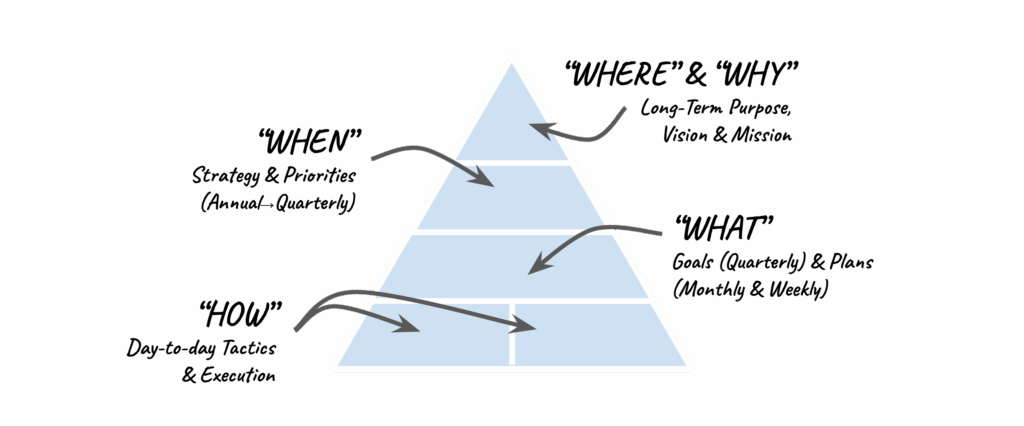Previously on … The Delegation Deception
- Delegation creates bottlenecks for multi-6 and 7-figure business owners
- This is because delegation doesn't take decisions off your plate
- If you want to unbottleneck your business, you need your team to make more decisions
- Combining "what" and "how" is part of what makes it hard to trust your team
At the start of 2016, Nathan Barry’s company ConvertKit was bringing in $98,000 in monthly recurring revenue.
There were six full-time team members, and they had less than one month’s worth of expenses in the bank.
Nathan spent most of his time working on growth, meeting with the team, designing new features, troubleshooting bugs, and just about everything else.
It was unsustainable, in more ways than one.
Fast-forward to the end of the year, when they ended up with $518,000 in MRR, over $1 million in profit, and twenty-four full time members.

Talk about riding the rocket ship.
More importantly, though, this was the year—as Nathan put it—that he became the CEO.
Here’s how he described it in his 2016 year in review:
Early in the year I became a bottleneck in so many decisions and processes that my leadership team finally called me out on it.
As the only designer in the company I was spending too much of my time on design and not on company-wide issues. Or when I’d get focused somewhere else I’d hold up the engineering team since they needed designs I couldn’t provide. So the directors team challenged me to not design anything for the entire month of June.
First, I panicked a bit. But someone had to design! We couldn’t live without a designer.
“Okay, then I’ll just hire a designer!”
Easy. Done. If I wasn’t able to design I had to get someone on the team who could still execute on my product vision. Obviously this is what my leadership team wanted. More time spent setting strategy and getting the right people in place and less time doing the hands-on work.
There's a few things going on here.
First, notice how Nathan says that he was the bottleneck on decisions and processes. Yes, the design tasks were a problem—but it wasn’t just the tasks he needed to get off his plate.
Second, notice that it was never going to be enough to get someone to “help” him with the design tasks; that would have still kept him in the weeds.
What Nathan needed was someone who could take over responsibility for the design work in its entirety, including all the decisions about how to execute on the vision.
Remember, the goal is that as long as your team knows “What” success looks like:
- What projects should we tackle?
- What KPIs should we track?
- What resources do we need, to give us the best chance of success?
- What are the success metrics for our team?
Then they can use their expertise to figure out the best way “How” to make it happen.
Once you’ve done that, you’ll be well on your way to having a team that can run itself.
But this is just the beginning.
Of course, what we don’t want is for a whole bunch of people running around, starting new projects willy-nilly.
That’s where the other two types of decisions come into play:
1. “When” decisions
“When” decisions are about choosing the strategic priorities that affect the business as a whole. For example…
- When is it time to reinvest our cash, versus building up a buffer?
- Should we prioritize growing top-line revenue or maximizing profit?
- Is now the right time to launch a new product?
- When should we hire someone to lead our sales & marketing team?
So you need a mechanism for ensuring that the right priorities are chosen & followed. That way, so you won’t have to worry about the what decisions going off the rails.
And how do you know that the right priorities will be chosen?
Well, you make sure that they are informed by the …
2. “Why” and “Where” decisions
These are your big-picture vision decisions. They determine your values, your culture, and the dent you’ll make in the universe:
- Where can we make the greatest impact?
- Where is the industry headed next?
- Where do we want to be in 10 years?
- Why does this business exist?
- Why should someone want to work with or for us?
Thus, we end up with
Four Types Of Decisions

1
How things are done
(tactics)
2
What gets done
(goals, projects, KPIs)
3
When things are done
(strategic priorities)
4
Why we do them, and where we’re going
(vision)
Each of these four is equally important. The ones at the bottom are simply the ones that happen more often.
How decisions, for example, happen daily… whereas changing the strategy and vision should happen much less frequently!
But at the end of the day, your business needs them all:
- If you don't have people deciding "How" nothing gets done.
- If the "What" isn't clearly communicated, no one knows what needs to be done.
- Without the "When," your team pulls in a million different directions,
- And without the "Why" and "Where", you'll never be able to achieve your vision.
If any one of the four types of decisions is missing, or even left to chance, the whole thing falls apart. And every time that happens, you have to jump in to pick up the pieces.
This is why it’s so critical that your business is structured in a way that lets your team take these decisions off your plate.
Because if they’re not, then you can never be free.
As Julie Parker told me (after she realigned her business with these decisions in mind):

“The biggest shift required was … to restructure things in such a way whereby the need for me to have to make decisions was lessened greatly.”
“This is about looking at how you can hire and set people up at high enough and strategic enough levels that your input becomes less and less required – or only in those areas you really want it to exist.”
Julie Parker
Beautiful You Coaching Academy
Speaking of which, I think it’s time we finally pull back the curtain on the framework that pulls this all together.
When you get this right ...
You won’t need a massive team, bloated by overpaid middle managers, or slowed down by unwieldy hierarchy.
You won’t waste hours chasing a dozen people around, writing and rewriting endless SOPs, or micromanaging everyone’s daily to-do lists.
You won’t have to wonder what’s taking so long, if you’re paying too much for what you’re getting, or if it would just be better to do it yourself.
Instead, your team will be empowered to take charge, make decisions, and move the business forward…
And you’ll no longer be caught in delegation hell, with every decision piling up around you and the entire business resting on your shoulders.
The only question that remains is … how do you do it?

Okay, maybe that’s not the only question left.
After all, you’ve heard some pretty big promises before.
You’ve been burned by people selling snake oil, and making such outsized claims that, when you stop to think about them, can only be considered nonsense.
(Like … I dunno … that you can ‘join the new rich by working four hours a week’?)
And so, it’s totally natural that you’d be wondering, “can this even work?”
Or maybe even “can it work for me?”
If that’s on your mind, then here’s the truth:
I can't make you any promises.
After all, I don’t know who you are and what’s going on inside your business.
And it’s not like I can jump through this computer screen and ask you a bunch of questions to find out.
So, who knows.
Maybe the old way of delegating out task after task is working just fine for you. If that’s the case, you don’t need to replace it.
Or maybe a strong command-and-control, top-down style of leadership fits with your values. If that’s the case, then letting your team make more decisions isn’t going to work.
Or maybe you don’t need a team at all, and would be better off building a Company of One, ala Paul Jarvis.
I don’t know.
But what I do know is that if you want to move beyond delegation…
And you know you’ve got great people on your team…
And you’d love for them to take at least some of the decisions off your plate…
… then you’ll probably want to at least consider aligning your business’ infrastructure with these four types of decisions.
The framework we use for doing that is called the Visionary Operating System.
So here's what I'd like to propose.
Let me take you behind the scenes, and show you how the Visionary Operating System actually works in practice.
I’ll show you how the whole thing played out for a handful of different businesses…
- In many different industries (education, legal, accounting, photography, media…)
- With many different business models (services, courses, group coaching, memberships, subscription boxes…)
- And with tiny teams ranging from 2-20+ people (contractors, employees, full-time, part-time…)
And then you can decide where to go from there.
Deal?